
Content
- Steps
- Part 1 of 4: Outline the plot
- Part 2 of 4: Create Characters
- Part 3 of 4: Get Started
- Part 4 of 4: Tell a Story
- Tips
Writing a detective story or any other novel is a truly daunting undertaking. First, outline a plot to organize your thoughts and drive away doubts about your abilities. Then introduce the characters, coming up with victims, suspects and main characters that are necessary for the plot to develop. After that, you can start writing history!
Steps
Part 1 of 4: Outline the plot
 1 Determine the location. You don't have to think about this first, but if you have a general idea of how you want the story to appear, consider the setting. This includes the location, time period, time of year, geographic location, and even climate and atmosphere.
1 Determine the location. You don't have to think about this first, but if you have a general idea of how you want the story to appear, consider the setting. This includes the location, time period, time of year, geographic location, and even climate and atmosphere. - Think about the atmosphere in your story. In part, it will depend on the scene.
- For example, a detective story about events in a small Soviet town in the 50s of the last century will be very different from a detective story taking place in Chicago today or Edinburgh in the 18th century.
- Or here's another example: the Sherlock Holmes stories mostly have such a dark atmosphere due to the time period in which they took place (Victorian and Edwardian eras) and because of the foggy London weather.
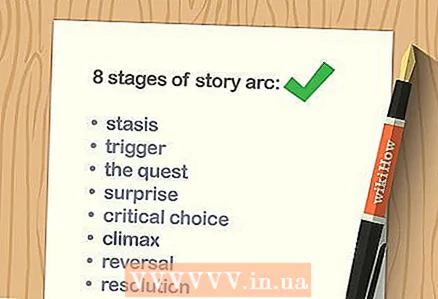 2 Build a story arc. The story arc demonstrates the development of the plot throughout the novel. Typically, eight stages are distinguished here: stasis, impulse, search, surprise, decisive choice, climax, turn, and denouement.
2 Build a story arc. The story arc demonstrates the development of the plot throughout the novel. Typically, eight stages are distinguished here: stasis, impulse, search, surprise, decisive choice, climax, turn, and denouement. - Stasis is a normal, daily life. You can start by describing the ordinary life of a detective, witness, or other character on behalf of whom you are narrating. Impulse is the event that triggers the search (in this case, the killer).
- Surprise is all about twists and turns, as well as difficulties that support the development of the plot. In a detective story, this can be new evidence, new motives that come up, or problems with finding a suspect.
- The decisive choice is the main hard question in the story of the protagonist. At this stage, the character must decide what to do in order to complete the story, and often he has to choose the difficult path. This moment defines the character. Typically, the choice leads to a climax - a stage where the action and tension reach their highest point, for example, when the detective actively catches the suspect.
- The turn and the denouement show how the characters have changed and what the new everyday looks like.

Lucy V. Hay
Professional writer Lucy W. Hay is a writer, script editor, and blogger. Helps other writers through workshops, courses and his Bang2Write blog. He is the producer of two British thrillers. Her detective debut, The Other Twin, is currently being filmed by Free @ Last TV, creator of the Emmy-nominated series Agatha Raisin. Lucy V. Hay
Lucy V. Hay
Professional writerStart with the question that the protagonist must answer. Writer and screenwriter Lucy Haye says: “The plot of detective stories is very complex, so, as a rule, they begin with some crime or a question to which one of the characters must answer. In addition, a character with detective skills is usually at the center of the mystery. He doesn't have to be a real detective, but he must have a burning desire to answer a question or solve a case. "
 3 Emphasize intrigue. It is important that the reader is lost in conjecture throughout the story. Of course, you can enter from the moment where the detectives examine the corpse at the scene of the crime, however, to make the plot more interesting, make the reader guess from the very beginning what is going on.
3 Emphasize intrigue. It is important that the reader is lost in conjecture throughout the story. Of course, you can enter from the moment where the detectives examine the corpse at the scene of the crime, however, to make the plot more interesting, make the reader guess from the very beginning what is going on. - Come up with an unlikely course of events. For example, one writer came up with a story where a woman changes her will, abandoning her children and leaving all her fortune to a dying man. Soon this man is killed. This situation is so unusual that readers want to know more.
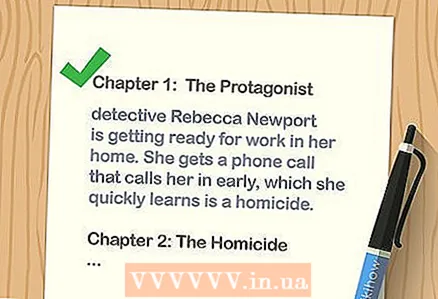 4 Make a plot development plan. Once you have identified the main arc, make a detailed outline of the story. Go through chapter by chapter and briefly describe what will happen in each one. This will make it easier for you when you sit down to work.
4 Make a plot development plan. Once you have identified the main arc, make a detailed outline of the story. Go through chapter by chapter and briefly describe what will happen in each one. This will make it easier for you when you sit down to work. - For example, you might write: “Chapter 1: Introduce the protagonist, Detective Rebecca Newport. Start with the stage at her house, where she is going to work. She gets an early phone call and soon finds out that it is murder. "
 5 Create physical, verbal, and thematic cues for the reader. Prompts mainly fall into three categories: physical, verbal, and thematic. Physical clues include, for example, blood drops, DNA analysis, and shoe sole prints. Verbal clues are what slips through conversations between characters, and thematic clues are, for example, the ominous environment when the killer appears or that the villain is dressed in black.
5 Create physical, verbal, and thematic cues for the reader. Prompts mainly fall into three categories: physical, verbal, and thematic. Physical clues include, for example, blood drops, DNA analysis, and shoe sole prints. Verbal clues are what slips through conversations between characters, and thematic clues are, for example, the ominous environment when the killer appears or that the villain is dressed in black. - Hints can be used in two ways.In the first case, they are immediately introduced into the plot (for example, the killer loses his decoration at the exit from the house), and the reader can either notice them or not pay attention to them. In the second case, clues appear as the plot progresses (for example, the result of a DNA test, which the reader will not be able to find out about before the detective).
- In addition, the clues differ in the degree of their obviousness. Some of them are very obvious, such as a pistol left at a crime scene. Others are more inconspicuous (for example, the victim wore purple, and this, as it turned out, is the key to solving the crime).
- It is not necessary to label all the clues in advance, but highlight a few key points and work through them throughout the story. Don't put everything in one scene at once.

Lucy V. Hay
Professional writer Lucy W. Hay is a writer, script editor, and blogger. Helps other writers through workshops, courses and his Bang2Write blog. He is the producer of two British thrillers. Her detective debut, The Other Twin, is currently being filmed by Free @ Last TV, creator of the Emmy-nominated series Agatha Raisin. Lucy V. Hay
Lucy V. Hay
Professional writerLead readers on the wrong track to add intrigue... Writer and screenwriter Lucy Haye says: “A good detective story should have elements that veil the central question. Perhaps the most famous of these is the red herring, where viewers think they know the culprit but are actually wrong. "
 6 Become an expert on the main topic of the story. To make the reader believe what you are writing, you need to know what you are talking about. If you want to write about a murder associated with a Japanese tea ceremony, you should know every detail of the ceremony, down to the smallest detail.
6 Become an expert on the main topic of the story. To make the reader believe what you are writing, you need to know what you are talking about. If you want to write about a murder associated with a Japanese tea ceremony, you should know every detail of the ceremony, down to the smallest detail. - You can search the Internet for information, but be sure to use other sources as well, such as visiting your local library.
- While it is very helpful to study the information, it is often best to have experience in the chosen field. For example, try to attend a tea ceremony whenever possible.
Part 2 of 4: Create Characters
 1 Make a profile for each character so as not to get confused. You can specify a description of appearance, background (what happened before the present events), level of education and place of work, as well as character traits.
1 Make a profile for each character so as not to get confused. You can specify a description of appearance, background (what happened before the present events), level of education and place of work, as well as character traits. - You can also add quirks and personality.
- Having a questionnaire to refer to will help you avoid confusion in the writing process.
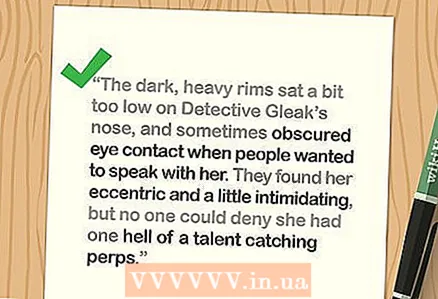 2 Make the character empathetic, but not necessarily sympathetic to the readers. “Cute” characters tend to be too white and fluffy with no depth of character. To create cohesive, interesting characters, empower them with flaws and weaknesses, while still allowing readers to feel connected with them.
2 Make the character empathetic, but not necessarily sympathetic to the readers. “Cute” characters tend to be too white and fluffy with no depth of character. To create cohesive, interesting characters, empower them with flaws and weaknesses, while still allowing readers to feel connected with them. - The downside might be that the character is always late, hates his mother, or doesn't get along with coworkers. If you need examples, think of people you know or have met in the past.
- There are many ways to make your characters empathetic. The hero may be in financial trouble or the victim in the story. It is possible in one of the scenes to expose the character to be disinterested, even if he acts in selfish interests at another time. For example, a killer just helps an old woman to remove a cat from a tree.
- For example, Sherlock Holmes is not necessarily sympathetic. However, he is interesting as a person, and readers empathize with him because he is very smart and good at what he does.
 3 Add some suspects. As a general rule, you shouldn't only point to one person as a suspect. What kind of mystery will this be? It is better to introduce several people who may be suspects (person 5-6).
3 Add some suspects. As a general rule, you shouldn't only point to one person as a suspect. What kind of mystery will this be? It is better to introduce several people who may be suspects (person 5-6). - Variety will keep the intrigue going, and readers will be at a loss.
 4 Come up with the suspects' motives. Each potential suspect must have a different motive for killing the victim, and each must be as believable as the next. Otherwise, the story may seem a little one-sided. For example, you shouldn't boil every murder motive to money.
4 Come up with the suspects' motives. Each potential suspect must have a different motive for killing the victim, and each must be as believable as the next. Otherwise, the story may seem a little one-sided. For example, you shouldn't boil every murder motive to money. - It is better to do this: the motive of one person is to keep a secret, the motive of another is to get money, and the third is simply jealous of the victim because of an affair on the side.
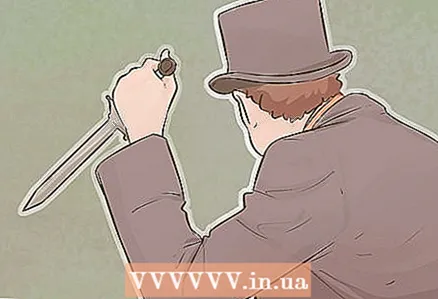 5 Make the killer believable. The person you ultimately choose to be guilty must be capable of crime in every way (both physically and emotionally). Otherwise, readers will feel cheated.
5 Make the killer believable. The person you ultimately choose to be guilty must be capable of crime in every way (both physically and emotionally). Otherwise, readers will feel cheated. - For example, a weak elderly person is unlikely to be able to lift the body and throw it off the bridge, no matter what state of passion he is.
 6 Get inside the detective's head. This is often the protagonist of a detective story. Whether you're telling the story from the perspective of a detective (deep but slightly distorted gaze) or from a third person (which gives a broader perspective on the story), you need to know your character intimately.
6 Get inside the detective's head. This is often the protagonist of a detective story. Whether you're telling the story from the perspective of a detective (deep but slightly distorted gaze) or from a third person (which gives a broader perspective on the story), you need to know your character intimately. - Deal with the following questions: Is the detective based entirely on logic, or sometimes relies on intuition? Does he have an extremely analytical mind, and he peers into every detail, or is he better at understanding the big picture of what is happening? What are its individual characteristics? What helps him to think correctly? Is he addicted to caffeine? Is he sleeping at his desk?
- Minor details will make the character look more realistic.
- For example, Sherlock Holmes has an extremely analytical mind, and he does not rely on intuition at all. In addition, he is overly rational and not emotional enough, which is why his relationships with people often suffer. Its features include, for example, the need for an interlocutor to discuss ideas, playing the violin and conducting strange experiments to learn more about solving crimes.
 7 Enter the victim (or victims). You can already show the victim dead at the beginning, and unravel the details of her life throughout history. Or you can imagine the victim as a character, and then move on to the murder.
7 Enter the victim (or victims). You can already show the victim dead at the beginning, and unravel the details of her life throughout history. Or you can imagine the victim as a character, and then move on to the murder. - When creating a victim, think about how it should contribute to the story. For example, if a nice person is killed, it will immediately turn the reader against the killer. However, if the victim was disgusting, perhaps the reader will justify the murderer.
- Create a back story for the victim so that the reader is not indifferent to her. Introduce details gradually throughout the story.
- It is even possible to make one of the potential suspects the next victim of the killer.
Part 3 of 4: Get Started
 1 Start with an action to entice the reader. It can be something dramatic, like the main character in a dangerous situation, or a reference to a scene that happens later. Or you can just use something insignificant to send the hero on a dangerous journey, taking him out of everyday life.
1 Start with an action to entice the reader. It can be something dramatic, like the main character in a dangerous situation, or a reference to a scene that happens later. Or you can just use something insignificant to send the hero on a dangerous journey, taking him out of everyday life. - Do not forget to add details of the setting as you go so that the reader understands where the action is taking place.
- For example, Dan Brown's The Da Vinci Code begins with the dramatic death of the curator of the Louvre, which instantly grabs the reader's attention.
 2 Introduce suspects through interactions and dialogues. One way to introduce suspects is to get them to interact with the victim prior to the murder, and the detective must witness their acquaintance. Another option is for the witness or person associated with the victim to name possible suspects to the detective.
2 Introduce suspects through interactions and dialogues. One way to introduce suspects is to get them to interact with the victim prior to the murder, and the detective must witness their acquaintance. Another option is for the witness or person associated with the victim to name possible suspects to the detective. - For example, a detective may witness a suspect and victim fighting before the victim is found dead.
- Or a detective might ask a neighbor: "Do you know if the victim had conflicts with someone?" The neighbor may answer: “Let me think. I saw a young man who visited Sveta late at night when her husband was not in town. I think this guy might be involved in this case. "
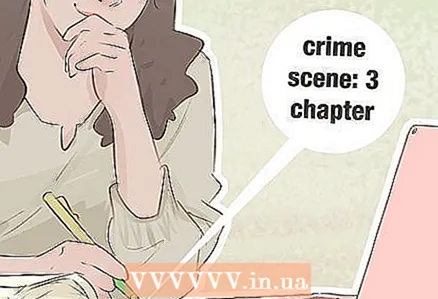 3 Add crime to one of the first three chapters. A detective story is a fast-paced story. It should not be delayed, because if the crime is still not committed by the third chapter, the reader will most likely lose interest and put the book down.
3 Add crime to one of the first three chapters. A detective story is a fast-paced story. It should not be delayed, because if the crime is still not committed by the third chapter, the reader will most likely lose interest and put the book down. 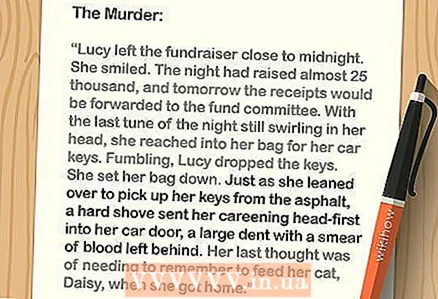 4 Work on the realism in the murder scene. As you try your hand at writing a detective story, you may realize that you don't really know much about killing a person. This is completely fine, but you should do some research to make the scene more realistic.
4 Work on the realism in the murder scene. As you try your hand at writing a detective story, you may realize that you don't really know much about killing a person. This is completely fine, but you should do some research to make the scene more realistic. - For example, stabbing a person is not as easy as it seems. It is actually quite difficult to thrust a knife into someone, especially if that someone is resisting.
- Keep in mind that most amateur assassins will make mistakes. They are not trained to kill, and most people don't even know how to deliver the killing blow. This means they will leave traces.
- Think about how to get rid of the body. The body is difficult to budge, and it is also quite noticeable. It will also leave behind blood and / or DNA traces and start to smell. Digging a hole takes a long time, and if the body is thrown into the water, it can be thrown back onto the shore.
Part 4 of 4: Tell a Story
 1 Introduce interrogations of suspects gradually and in different settings. If you do every police interrogation, it will stop history. Better to have the detective interrogate one person in the house where the murder took place, another at the police station, another on the street as a neighbor, and so on.
1 Introduce interrogations of suspects gradually and in different settings. If you do every police interrogation, it will stop history. Better to have the detective interrogate one person in the house where the murder took place, another at the police station, another on the street as a neighbor, and so on.  2 Give the reader a chance to solve the crime by adding clues throughout the story. Of course, at the end of the story, you can tell about the fingerprint on the battery from the flashlight, but this is not entirely true in relation to the reader. Better at least hint at this at a certain point in history.
2 Give the reader a chance to solve the crime by adding clues throughout the story. Of course, at the end of the story, you can tell about the fingerprint on the battery from the flashlight, but this is not entirely true in relation to the reader. Better at least hint at this at a certain point in history. - For example, it can be noted that a flashlight was left at the scene of the incident, carefully wiped off the outside. Or mention a fingerprint taken from a battery.
 3 Point the wrong direction with hints. Clues can lead to multiple people at once, or to one person who may seem like the obvious choice of the villain, but ultimately won't be the killer. This tactic is called deception. You show the reader all the evidence, but send him on the wrong track.
3 Point the wrong direction with hints. Clues can lead to multiple people at once, or to one person who may seem like the obvious choice of the villain, but ultimately won't be the killer. This tactic is called deception. You show the reader all the evidence, but send him on the wrong track. - For example, one of the suspects may be a hiker, and large footprints from hiking boots remain at the crime scene. In fact, these marks may have been left by a woman who borrowed her husband's boots.
 4 Maintain the pace without deviating from the plot. Throughout the book, keep the reader interested in learning more by making them turn the pages. A detective story should have a dynamic plot, so don't get bogged down in ominous surroundings and ornate descriptions. Follow the plot through the outline so you know where the story is heading.
4 Maintain the pace without deviating from the plot. Throughout the book, keep the reader interested in learning more by making them turn the pages. A detective story should have a dynamic plot, so don't get bogged down in ominous surroundings and ornate descriptions. Follow the plot through the outline so you know where the story is heading. - Similarly, with each chapter, introduce a new story element. At the end of the chapter, the reader must wonder what will happen next. You can enter a new clue that will point to another suspect, and the reader will have to keep reading to see if the guess is correct.
 5 Add a plot twist towards the end. Towards the end of a good detective story, an unexpected twist occurs that amazes the reader. However, this turn should not be so sharp that the reader feels deceived. Rather, he must follow the logic and clues of history, but in an unexpected way.
5 Add a plot twist towards the end. Towards the end of a good detective story, an unexpected twist occurs that amazes the reader. However, this turn should not be so sharp that the reader feels deceived. Rather, he must follow the logic and clues of history, but in an unexpected way. - For example, perhaps all the clues pointed to the fact that the killer was the only son of a rich man, since it seemed that only he had a motive to kill the victim. And the twist could be that the man had another child - a daughter, who must also inherit the fortune after his death. Hints should be suitable for both son and daughter so that the reader does not feel deceived.
- Another example is the famous twist in the book / movie Murder on the Orient Express (spoiler alert!). At the end, the reader / viewer learns that in fact all the suspects conspired to commit murder, and no one was the culprit.
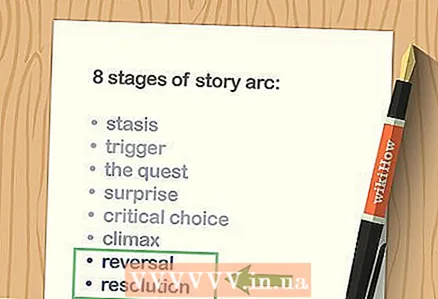 6 Work on the turn and interchange after the climax. Once the killer is caught, note how the characters have changed for the better or worse. Then show them how they get back to normal.
6 Work on the turn and interchange after the climax. Once the killer is caught, note how the characters have changed for the better or worse. Then show them how they get back to normal. - For example, perhaps a detective crosses the lines of ethics and decides to leave the police force. Now he can look for a new job.
- Or perhaps the detective was a rookie and would be promoted after the case was solved.
Tips
- Make it your goal to write every day. For example, write 500 words a day or 3 hours a day. Either way, stick to the goal to make progress.
- Spend some time reading novels in this genre to get a better understanding of them.



